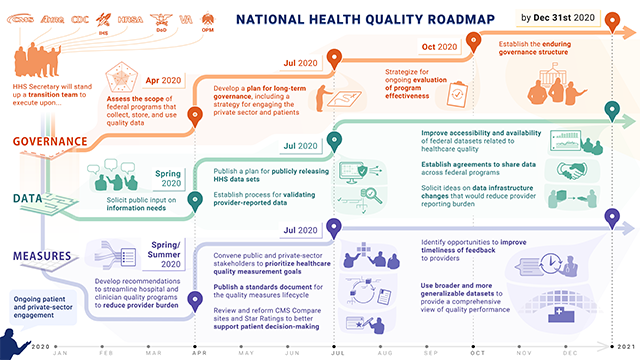National Health Quality Roadmap
On June 24th, 2019, President Trump issued Executive Order 13877, Improving Price and Quality Transparency in American Healthcare to Put Patients First. The purpose of the executive order is to empower patients to make fully informed decisions about their healthcare, by facilitating the availability of appropriate and meaningful price and quality information. Section 4 of the executive order specifically directed the Secretaries of the Department of Health and Human Services (HHS), Department of Defense (DoD), and Department of Veterans Affairs (VA) to publish a Health Quality Roadmap detailing a strategy for establishing, adopting, and publishing common quality measurements; aligning inpatient and outpatient measures; and eliminating low-value1 or counterproductive measures.
Between July and December 2019 HHS Deputy Secretary Eric Hargan convened a series of meetings of government and private sector quality experts to address the Executive Order's mandate. Representatives from the VA, DoD, CMS, HRSA, AHRQ, the Indian Health Service and OPM engaged with representatives from patient groups, hospitals, physician societies, nursing homes, tech companies and quality measurement organizations to develop strategies for improving the Federal Government's administration of the healthcare quality enterprise. The attached Roadmap is the product of their efforts.
Due to the COVID-19 pandemic, some of the project timelines in the Roadmap will be pushed back. HHS is nevertheless committed to implementing the programs outlined, with the intent of improving the healthcare quality enterprise for the benefit of the American people.
Improvements in the federal QME will equip patients with more meaningful information and enable greater patient engagement in their treatment and care planning.
The purpose of this Roadmap is to improve patient2 outcomes through enhanced effectiveness and efficiency of the healthcare quality system supported by federal investments. The federal government serves as a leader, and this Roadmap identifies policy and regulatory levers to drive change. True system advancement cannot occur without private sector stakeholders as equal partners in this endeavor, and the Roadmap implementation will be an opportunity for public-private partnership. When implemented, this Roadmap will improve alignment of quality measures across federal programs and improve the value delivered by those measures. Improvements in the federal Quality Measurement Enterprise (QME)3 will equip patients with more meaningful information and enable greater patient engagement in their treatment and care planning.
Download a print version of the National Health Quality Roadmap
Summary
This Roadmap identifies specific actions to drive change through governance and oversight, data collection and reporting, and aligned measures in federal quality programs. The infographic in Figure 1 below summarizes the planned actions and general timing for milestones. When implemented, this Roadmap will accelerate change and advance the Administration's goals of improving transparency, reducing provider burden, allowing informed consumer decision-making, and ultimately improving the health of all Americans.
Learn more about the National Health Quality Roadmap
Introduction
Read about the unified approach and the key principles driving the Roadmap
Opportunity for Change
Discover the three ways the Roadmap will improve health quality
Call to Action
Find out what actions are planned for 2020 to move forward with the Roadmap
* The HHS Secretary will stand up a transition team to execute on three simultaneous work streams: Governance, Data, and Measures.
Governance: By April 2020, the transition team will assess the scope of federal programs that collect, store, and use quality data. By July 2020, they will develop a plan for long-term governance including a strategy for engaging the private sector and patients. By October 2020, they will develop a mechanism for ongoing evaluation of program effectiveness. And finally, by December 31, they will establish the enduring governance structure.
Data: By Spring 2020, the transition team will solicit public input on information needs. By July 2020, they will publish a plan for publicly releasing HHS data sets and establish a process for validating provider-reported data. By December 31, 2020, they will improve accessibility and availability of federal datasets related to healthcare quality, establish agreements to share data across federal programs, and solicit ideas on data infrastructure changes that would reduce provider burden.
Measures: This will require ongoing patient and private-sector engagement. By Spring/Summer 2020, they will develop recommendations to streamline hospital and clinician quality programs to reduce provider burden. By July 2020, they will convene public and private-sector stakeholders to prioritize healthcare quality measurement goals, publish a standards document for the quality measures lifecycle, and review and reform CMS Compare sites and Star Ratings to better support patient decision-making. By December 31, 2020, they will identify opportunities to improve timeliness of feedback to providers and use broader and more generalizable datasets to provide a comprehensive view of quality performance.
- 1. For purposes of the Roadmap, value is defined as the ratio of healthcare quality, safety, and patient experience to the cost of care.
- 2. This Roadmap uses the term "patient" to align with language in the Executive Order and is meant to include all consumers of healthcare services and their caregivers.
- 3. For purposes of this document, the quality measurement enterprise includes the broad array of organizations and individuals who develop and steward measures of health quality; collect and report data on those measures; and use quality measure information.
